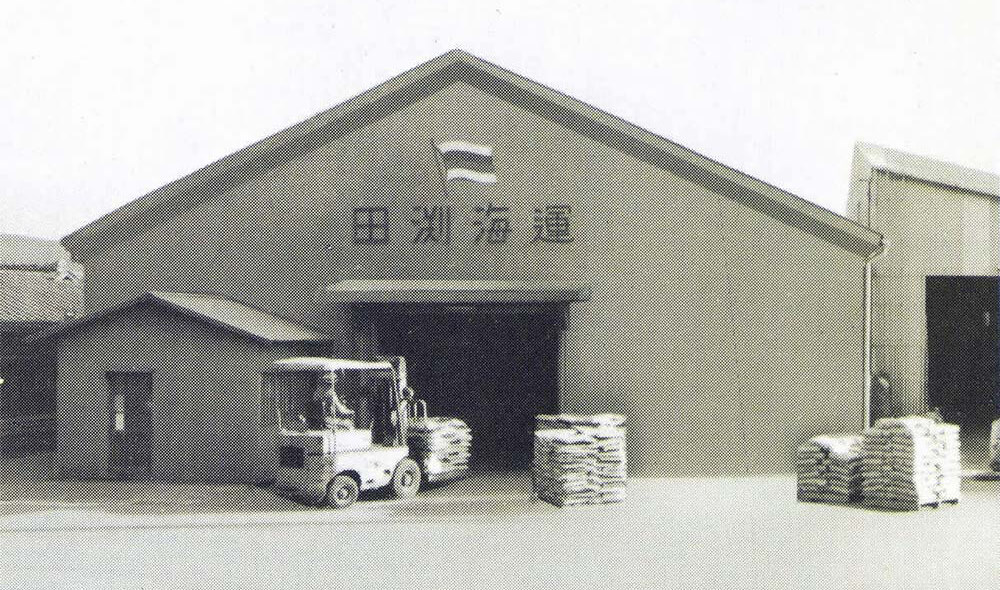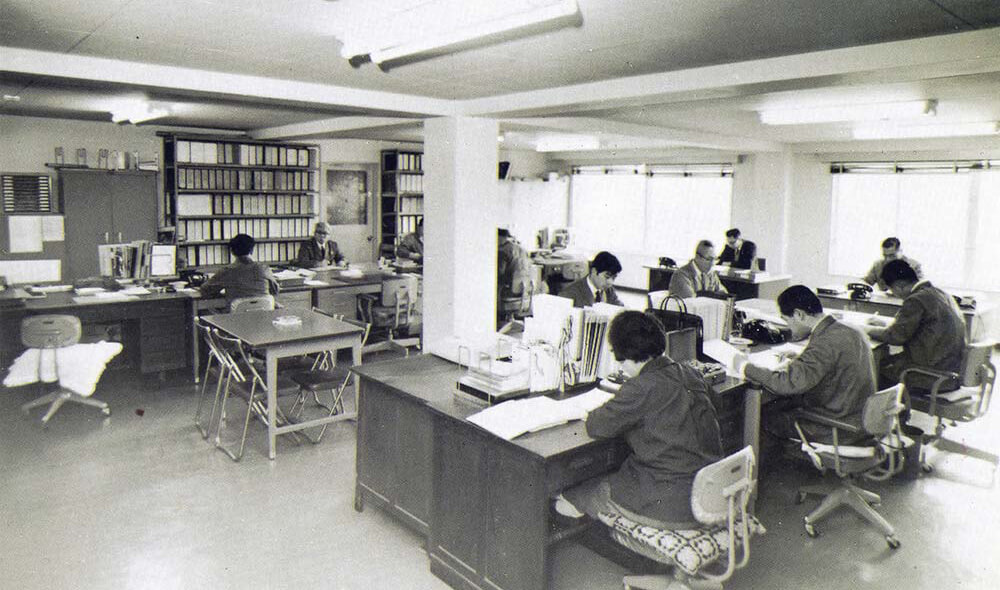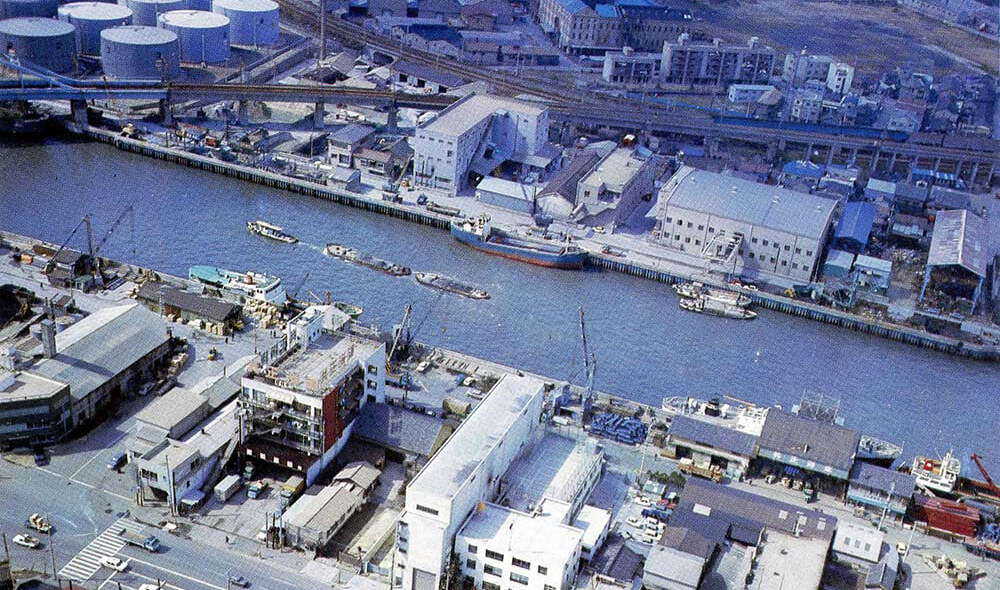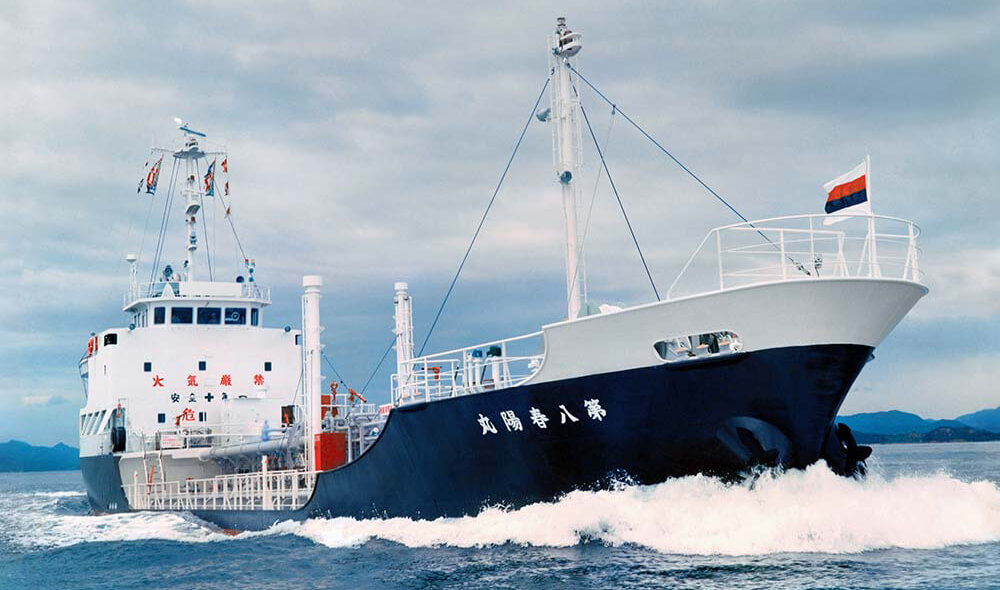
Early period
Upon the orders of Sumitomo Fertilizer Factory Co., Ltd. (currently Sumitomo Chemical Co., Ltd.), which had planned the construction of its factory in Niihama, Ehime, in 1913, Iwataro Tabuchi, the first owner of the Company, participated in projects of sea and land transportation of raw materials; receiving goods in factories; packing, exporting, and sea and land transportation of products; and related port cargo handling.
In 1917, Tabuchi Shoten was founded in Tomishima-cho, Nishi-ku, Osaka, at the Factory's suggestion mainly as the main contractor for the transportation of their materials and products, and transportation services between Niihama and Osaka, as well as other routes, began. As the Niihama Port was too small for large vessels to enter at that time, raw materials were transferred to small ships at the Hanshin Port to be transported.
In 1919, Tabuchi Shoten transported fertilizers from Niihama to Moji and Wakamatsu and coal from various parts of Kyushu to the Hanshin area. As Sumitomo Fertilizer Factory expanded its sales routes to Kyushu, Hanshin, Nagoya, Tokyo, Hokkaido, Korea, Taiwan, and so on, we enhanced our own vessels, chartered ships, and engaged in the implementation of our transportation mission to lay the foundation for our business.
After the Great Kanto Earthquake in September 1923 burned the city of Tokyo to the ground, upon the order of the head office of Sumitomo, we transported a full load of drinking water and relief supplies to support Sumitomo's stakeholders. Consequently, Sumitomo Shunyo Association was established to commemorate the event for a long time.
In 1924, as the draft of the Niihama Port at that time was as shallow as 10 feet (approximately 3 meters) and steamers could not enter the port, Tabuchi Shoten constructed a specialized carrier for handling fertilizers and copper materials at quays in response to the request of Sumitomo Fertilizer Factory and Sumitomo Besshi Mining Plant. The carrier was Japan's first vessel equipped with a semi-diesel engine, which was a revolutionary endeavor, and the ship was called a “marine truck” at that time.
On the basis of these experiences, in 1925 we received an order for the transportation of coal between Wakamatsu and Osaka from Sumitomo Copper and Brass Co., Ltd. (later: Sumitomo Metal Industries, Ltd., currently: Nippon Steel & Sumitomo Metal Corporation).
At that time, Tabuchi Kaiun had already established the foundation for its marine transportation business with the operation of regular liners on the routes between Osaka, Niihama, and Wakamatsu (fertilizers, sundries, steel materials, glass, etc.); Osaka, Hyogo, Akashi, Suma, Aioi, and Hinase (cargo-passenger ships); Osaka and Busan (Korea); and Jeju Island (cargo-passenger ships). Tabuchi Kalun had also established the operation of tramp steamers on the routes between Osaka, Niihama, and Kyushu ports (fertilizer and coal); Osaka, Niihama, Kyushu, Nagoya, Tokyo, Hokkaido, Taiwan, and Korea; and Wakamatsu and Osaka (coal).

Expansion period
In 1929, Tateki Tabuchi took over the business from Iwataro Tabuchi. Following the establishment of a branch in Niihama to increase the transaction volume of fertilizers and coal, branches were established in Wakamatsu, Hakata, Karatsu, Shisa, Sasebo, and Nagasaki for the subsequent increase in coal transportation in Kyushu. In addition, the operation of five vessels for the transportation of sundries and coal from Hanshin to Kyushu and two vessels for the transportation of cement, steel, and other materials to Korea began, after which the route was expanded to Tianjin.
In 1930, upon the orders of Sumitomo Coal Mining Co., Ltd., Sumitomo Steel Works Co., Ltd., Yasukawa Matsumoto Shoten Co., Ltd., Furukawa Mining Co., Ltd., Aso Shoten Co., Ltd., Mitsubishi Mining Co., Ltd., Japan Drop Forge Co., Ltd., and other companies, we engaged in coal transportation in Kyushu. While the vessels in service at that time were 500 to 1,000 deadweight ton types, the monthly transportation volume reached 30,000 to 50,000 tons, and Sumitomo Fertilizer Factory Co., Ltd. started full-scale FOB coal transportation, so we received orders for the transportation of coke. It was also in that year that we undertook the Osaka collection agency of Kuribayashi Steamship Co., Ltd. and began the transportation of sundries to Hokkaido and Karafuto.
Tabuchi Shoten was incorporated and became Tabuchi Shoten Co., Ltd. in 1935; the first shop owner, Iwataro Tabuchi, assumed the position of chairman and Tateki Tabuchi became president. The head office was relocated to the current location, 2 Chome Ajigawa, Nishi-ku, Osaka-shi.
In 1938, the FOB coal transportation volume of Sumitomo Chemical Co., Ltd. increased significantly, and the monthly transportation volume for the electric companies of Meiji Mining Co., Ltd., Sumitomo Coal Mining Co., Ltd., and Nakajima Mining Co., Ltd., and other CIF agreements reached approximately 100,000 tons.
The Company's name was changed to Tabuchi Kaiun Co., Ltd. in 1941. As the wartime regulations were tightened around that time, the marine transportation industry was integrated into business associations. When the Pacific War broke out in December of the same year, all domestic ships became subject to military use. Under these circumstances, the Company was allowed to continue its business as a transportation agency of Sumitomo Chemical Co., Ltd. in principle to cooperate with the Ship Management Association, a shipping control organization.
During wartime, when Sumitomo Chemical Co., Ltd. built a factory in the city of Wakayama, Sumika Group Co., Ltd. (currently Sumika Transportation Co., Ltd.) was established in 1943 to engage in the transportation of construction materials and operations in the factory.
After the war, war-damaged facilities were restored, and we received a new order for transportation from Beppu Chemical Industry Co., Ltd. (currently Sumitomo Seika Chemicals Co., Ltd.). After the vessels conscripted for military service were returned to the Company, we aimed to increase the number of vessels, reinforced our role as a transport agency of Sumitomo Chemical Co., Ltd., and expanded our sales channels for the transportation of fertilizers, coal, coke, and other materials.
In 1948, the Tokyo branch (currently Tokyo Branch Office) was established to enhance sales.
With the development of petrochemistry by Sumitomo Chemical Co., Ltd. around 1958, we started the transportation of naphtha and heavy oil in tankers remodeled from cargo ships. In 1964, as a result of the progress in petrochemicals, the number of clients increased and vessels were improved to enhance the transportation of methanol, naphtha, and other chemical products. In 1965, in collaboration with Sumitomo Corporation, Zeon Corporation, and Sumitomo Chemical Co., Ltd., we built our first LPG tanker and advanced to the LPG sector, which became the foundation of our subsequent advancement to the specialized vessels field.

Development period
In 1966, Yuichiro Tabuchi assumed the position of president upon the death of Tateki Tabuchi.
In 1968, the Chiba branch was established following the operation of the Chiba Petrochemical Complex. In addition, the first domestic tanker for the transportation of Indonesian Minas crude oil, Keisei Maru (2,000 tons burden), went into service primarily for Sumitomo Metal Industries Co., Ltd., Wakayama Steel Works Co., Ltd., and Wakayama Kyodo Power Company, Inc. It was also in this year that Japan's first aluminum barge, Maruta No. 2 (250 tons burden), was constructed.
During the next three years, from 1969 to 1971, while establishing the foundation for advancement to the special vessels sector by constructing five domestic LPG carriers, four acetic acid carriers, two sulfuric acid carriers, seven chemical tankers, a methanol carrier, and a cement carrier with the support of Zeon Corporation, Ltd., Idemitsu Kosan Co., Ltd., Showa Denko Co., Ltd., Dowa Mining Co., Ltd., and Aso Cement Co., Ltd., we enhanced four Minas oil tankers, two black fuel carriers, five gasoline and distilled oil tankers, and eight cargo ships. In addition, we launched large alumina carriers and constructed two coastal cargo ships to advance to the transportation of south-sea wood.
In 1970, the Toyama Plant of Sumitomo Chemical Co., Ltd. and the Toyama branch were established as a result of the increase in the volume of transportation in the Hokuriku region. The Oita branch was also established because of the increase in the volume of transportation in the Oita coastal industrial zone.
Transportation of ocean-going cargo started with the Hosei Maru, a propylene oxide chemical tanker for domestic and international marine transportation services constructed in 1975 for Nihon Oxirane Co., Ltd., and transportation of Marubeni Corporation's propylene to Tianjin, China started and expanded in 1977 with Hakusei Maru No. 25, an LPG tanker for domestic and international marine transportation services.
In 1970, we advanced to the warehousing industry and established the Ajigawa Bonded Shed (capacity: 1,300 tons), as well as the Ajigawa Warehouse (bonded shed, 596 m²), next to the head office building. In 1974, we secured two municipal sheds of Osaka Nanko Keihin Berth (3,862 m²) as the distribution base for the sea and land intermodal transportation system and a warehouse space (2,969 m²) in the hinterland. The Osaka Nanko Office and the Tomishima Bonded Shed (948 m²) were also established. The Warehouse Department constructed the first warehouse (four-storied building with reinforced steel, 6,347 m²) in the hinterland of the Osaka Nanko Keihin Berth in 1973. We secured a site (7,159 m²) as a local collection terminal in Sodegaura, Chiba, and constructed three steel one-story warehouse buildings in 1974; the second Osaka Nanko warehouse (three-storied building with reinforced steel, 14,978 m²) in 1976; the third Osaka Nanko warehouse (steel-frame, one-story building, 2,000 m²) and the one-story steel warehouse building (270 m²) on the west side of Ajigawa Warehouse in 1984; the Nanko South Warehouse (three-storied building with reinforced steel, 3,362 m²); the Nanko Central Warehouse (three-storied building with reinforced steel, 8,159 m²) in 1986; and the Nanko Central Warehouse (four-storied building with reinforced steel, 6,649 m²) in 1991.
We continued to expand our sales channels and number of vessels, and as a result, the number of partner shippers increased to 500 companies and the number of ships in operation increased to 106 (115,955 deadweight tons). With the expansion of the Warehouse Port Transportation Department, we began the operation of the sea and land intermodal transportation system, aiming at more stable shipping as a comprehensive marine transportation company.
In the meantime, Tabuchi Kaiun Safety Transportation Council was established in 1972 to promote safe shipping management, and in 1981, the Safety Management Division was established to further enhance safe shipping management. In 1997, we obtained a certificate of the International Safety Management (ISM) Code.
In 1992, the chemical tanker Shosei Maru was constructed for domestic and international marine transportation services, and Idemitsu Petrochemical Co., Ltd soon started transporting polybutene to Singapore. In 1995, an International Shipping Office was established in the Sales Department and the LPG tanker BATANGAS for international marine transportation services started operation for Marubeni Corporation, and in 1996 and 1998 respectively, BUENA GRACIA and BUENA ESTELA started operation.
In 1997, a full-scale entry into ocean shipping routes began, starting with operation of the propylene oxide chemical tanker ENNERDAIL for Mitsubishi Chemical Corporation and then the start of operation of the chemical tanker SUN INVESTOR in the same year.

Enhancement period
In 2000, Norio Tabuchi assumed the office of president upon the death of Yuichiro Tabuchi.
In 2002, we established the East Warehouse in Nanko, Osaka (four-storied steel-frame building, 8,859 m²); obtained the ISO9001 certification in domestic and international marine transportation services; and constructed the company's first large gasoline and distilled oil tanker of 6,000 kiloliters burden. Subsequently, in 2003, we acquired ISO14001 in vessel management of domestic oil tankers, chemical tankers, and gas carriers. In 2004, the operation of the company's first ethylene carrier began, and in 2005, the company's first large, multi-use (black fuel, gasoline, and distilled oil) tanker of 6,000 kiloliters burden was constructed.
In the Ocean Shipping Department, in 2003 the specially designed propylene oxide specification small-lot chemical tankers PRINCESS OPAL and PRINCESS CRYSTAL in which all the knowhow accumulated until the present was utilized began operations. In 2006, organizational restructuring was carried out to create the International Shipping Department, operation of the ocean-going LPG tanker BUENA VENUS started, and the fleet was sequentially developed and expanded and currently 11 ocean-going LPG tankers and 10 ocean-going chemical tankers are operated.
The Warehouse Department was divisionalized in 2006, and Tabuchi Soko Co., Ltd. was established. The construction of the third Osaka Nanko Warehouse (four-storied building with reinforced steel, 7,134 m²) of the same company was completed in 2008, and the Hirabayashi Warehouse (12,403 m²) was completed in 2014.
With the expansion of the Ocean Shipping Department, we established a subsidiary in Singapore in March 2008.
Meanwhile, with business expansion in the Coastal Shipping Department, the maintenance of chemical tankers and LPG carriers was actively performed.



